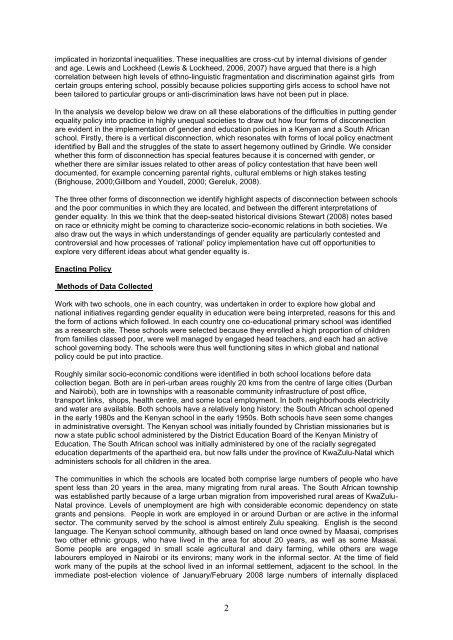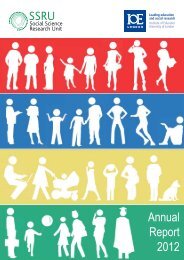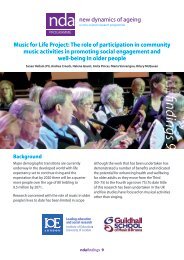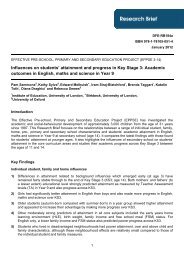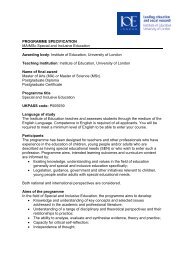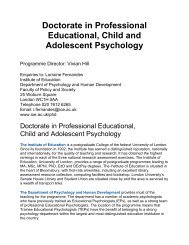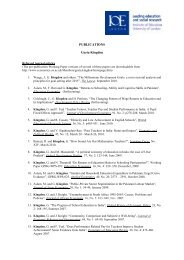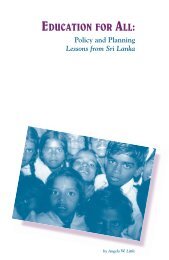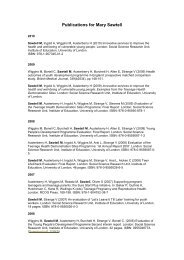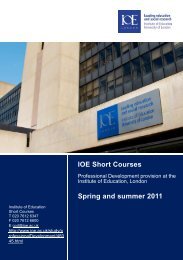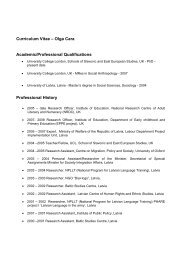Working paper 1 (pdf - Institute of Education, University of London
Working paper 1 (pdf - Institute of Education, University of London
Working paper 1 (pdf - Institute of Education, University of London
You also want an ePaper? Increase the reach of your titles
YUMPU automatically turns print PDFs into web optimized ePapers that Google loves.
implicated in horizontal inequalities. These inequalities are cross-cut by internal divisions <strong>of</strong> gender<br />
and age. Lewis and Lockheed (Lewis & Lockheed, 2006, 2007) have argued that there is a high<br />
correlation between high levels <strong>of</strong> ethno-linguistic fragmentation and discrimination against girls from<br />
certain groups entering school, possibly because policies supporting girls access to school have not<br />
been tailored to particular groups or anti-discrimination laws have not been put in place.<br />
In the analysis we develop below we draw on all these elaborations <strong>of</strong> the difficulties in putting gender<br />
equality policy into practice in highly unequal societies to draw out how four forms <strong>of</strong> disconnection<br />
are evident in the implementation <strong>of</strong> gender and education policies in a Kenyan and a South African<br />
school. Firstly, there is a vertical disconnection, which resonates with forms <strong>of</strong> local policy enactment<br />
identified by Ball and the struggles <strong>of</strong> the state to assert hegemony outlined by Grindle. We consider<br />
whether this form <strong>of</strong> disconnection has special features because it is concerned with gender, or<br />
whether there are similar issues related to other areas <strong>of</strong> policy contestation that have been well<br />
documented, for example concerning parental rights, cultural emblems or high stakes testing<br />
(Brighouse, 2000;Gillborn and Youdell, 2000; Gereluk, 2008).<br />
The three other forms <strong>of</strong> disconnection we identify highlight aspects <strong>of</strong> disconnection between schools<br />
and the poor communities in which they are located, and between the different interpretations <strong>of</strong><br />
gender equality. In this we think that the deep-seated historical divisions Stewart (2008) notes based<br />
on race or ethnicity might be coming to characterize socio-economic relations in both societies. We<br />
also draw out the ways in which understandings <strong>of</strong> gender equality are particularly contested and<br />
controversial and how processes <strong>of</strong> „rational‟ policy implementation have cut <strong>of</strong>f opportunities to<br />
explore very different ideas about what gender equality is.<br />
Enacting Policy<br />
Methods <strong>of</strong> Data Collected<br />
Work with two schools, one in each country, was undertaken in order to explore how global and<br />
national initiatives regarding gender equality in education were being interpreted, reasons for this and<br />
the form <strong>of</strong> actions which followed. In each country one co-educational primary school was identified<br />
as a research site. These schools were selected because they enrolled a high proportion <strong>of</strong> children<br />
from families classed poor, were well managed by engaged head teachers, and each had an active<br />
school governing body. The schools were thus well functioning sites in which global and national<br />
policy could be put into practice.<br />
Roughly similar socio-economic conditions were identified in both school locations before data<br />
collection began. Both are in peri-urban areas roughly 20 kms from the centre <strong>of</strong> large cities (Durban<br />
and Nairobi), both are in townships with a reasonable community infrastructure <strong>of</strong> post <strong>of</strong>fice,<br />
transport links, shops, health centre, and some local employment. In both neighborhoods electricity<br />
and water are available. Both schools have a relatively long history: the South African school opened<br />
in the early 1980s and the Kenyan school in the early 1950s. Both schools have seen some changes<br />
in administrative oversight. The Kenyan school was initially founded by Christian missionaries but is<br />
now a state public school administered by the District <strong>Education</strong> Board <strong>of</strong> the Kenyan Ministry <strong>of</strong><br />
<strong>Education</strong>. The South African school was initially administered by one <strong>of</strong> the racially segregated<br />
education departments <strong>of</strong> the apartheid era, but now falls under the province <strong>of</strong> KwaZulu-Natal which<br />
administers schools for all children in the area.<br />
The communities in which the schools are located both comprise large numbers <strong>of</strong> people who have<br />
spent less than 20 years in the area, many migrating from rural areas. The South African township<br />
was established partly because <strong>of</strong> a large urban migration from impoverished rural areas <strong>of</strong> KwaZulu-<br />
Natal province. Levels <strong>of</strong> unemployment are high with considerable economic dependency on state<br />
grants and pensions. People in work are employed in or around Durban or are active in the informal<br />
sector. The community served by the school is almost entirely Zulu speaking. English is the second<br />
language. The Kenyan school community, although based on land once owned by Maasai, comprises<br />
two other ethnic groups, who have lived in the area for about 20 years, as well as some Maasai.<br />
Some people are engaged in small scale agricultural and dairy farming, while others are wage<br />
labourers employed in Nairobi or its environs; many work in the informal sector. At the time <strong>of</strong> field<br />
work many <strong>of</strong> the pupils at the school lived in an informal settlement, adjacent to the school. In the<br />
immediate post-election violence <strong>of</strong> January/February 2008 large numbers <strong>of</strong> internally displaced<br />
2


